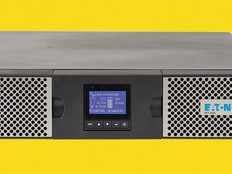Four Tiers of Storage to Help Federal Agencies Meet Growing Data Needs
The numbers can seem daunting: McKinsey & Company predicts that the amount of data generated will grow 40 percent each year through 2020. With a high percentage of that data now digital, particularly video content, data sets and storage demands are getting larger. Agencies that use video surveillance are dealing with that growth firsthand.
It is often necessary to store surveillance video for a long periods of time, and the files tend to be very large. In fact, according to a Seagate white paper, “over 18.4 billion gigabytes (GB) of storage is needed to support the world’s surveillance cameras for a mere two-week recording period” which is “880 times more than the entire capacity manufactured in the year 1995.”
As this type of mission-critical data continues to increase, government IT managers require more-efficient storage infrastructures. Often, though, growth-driven storage demand is hindered by tightened budgets. Surveillance data and other content is an important asset for agencies, yet few have an optimized, secure storage strategy in place.
Many federal contractors deal with the data deluge by buying more primary storage. While this approach keeps data close at hand, it is extremely expensive and makes it difficult to find specific data — similar to looking for a needle in a haystack. A better solution can be found in storage tiering, where data is stored in different sets, based on the data’s current value to the organization. This keeps the data readily available when it is most needed, while securely and cost-effectively storing it for later use.
Storage tiering is not a new concept, but it may be new to growing agencies that are being increasingly challenged by the volume of data they are creating. By learning about tiered storage, and by building data archiving, backup and other data-management solutions on top of a tiered storage infrastructure, agencies can reduce storage costs, quickly transfer large data sets and safeguard valuable data. The tiered approach uses higher-cost storage for mission-critical data; lower-cost storage for nearline access; and removable tapes or disks, or cloud storage, for low-access data needs.
Tier One: Online
The online storage tier is where a company’s active, primary production data resides. High-cost, online storage is usually reserved for data that is most frequently accessed and is of highest importance, yet many organizations still use the same storage for backup. This approach is expensive and susceptible to failure.
Tier Two: Nearline
The nearline tier represents an intermediary stage between online storage, which enables rapid data access, and offline storage, which is more affordable but requires more time for data access. To reduce storage costs without dramatically reducing speed of data access, companies can replicate data to a nearline data-protection device. They can also set policies for types of data that should be stored online or nearline. This tier of data access can provide a copy of data in the event that online data is compromised.
Tier Three: Offline

Credit: iStockphoto/Thinkstock
2.7 trillion gigabytes
Amount of data created in 2012
SOURCE: IDC Digital Universe
The offline tier maintains copies of archived data at a physically remote location. The best data-management solutions enable multiple ways to do this, including removable media that can be transported to another site. RDX is a good example of a removable media format that delivers cost-efficient backup, recovery and archiving. RDX offers all of the advantages of disk-to-disk storage, including high performance and a low failure rate, plus the removability and portability of tape. As removable storage, RDX supports offsite storage for disaster recovery and offers a practical way to seed cloud storage. New versions of RDX media also feature encryption and cryptographic-erase capabilities.
Tier Four: Offsite
Agencies need a system that will provide not only an onsite copy of data for fast restoration but also an offsite copy if the primary storage location is damaged. As confidence in cloud providers continues to increase, more companies will use cloud storage for offsite backup. The main benefits of cloud storage are threefold: First, the cloud provides true disaster recovery and business continuity. It adds critical offsite storage to ensure that an agency’s most important asset is accessible in the event of a disaster. Second, cloud providers offer pay-as-you-go options, which enable agencies to account for storage as an operational expense, not a capital expense. Finally, cloud storage is scalable, and additional capacity can be used when needed. However, it is important to keep in mind that scalability is not just about the size or amount of storage; the speed of access and throughput must also be scalable.
A four-tier storage approach offers agencies scalability and agility as the amount of data being stored increases exponentially. Agencies should look for appliances that support increased-capacity media cartridges or the easy addition of new appliances or arrays. Overhauling a storage infrastructure on a tight budget is a serious challenge. Implementing a four-tiered storage strategy is the best approach for cost-effective optimization and data backup.






